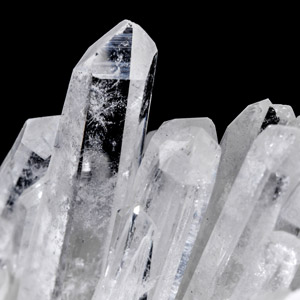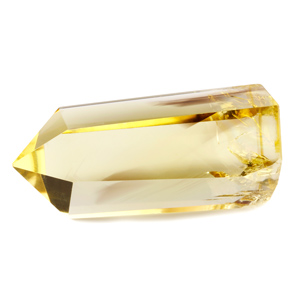quartz
Quartz, a versatile and abundant gemstone, owes its name to the ancient German word "querklufterz," which referred to cross-vein ore. Composed of silicon dioxide, quartz is one of the most abundant minerals on Earth, and its varieties showcase a dazzling spectrum of colours.
Quartz's geological origins are diverse, as it forms in a wide range of environments. It can be found in igneous, metamorphic, and sedimentary rocks. Quartz crystals often grow in cavities within these rocks, producing magnificent specimens known for their clarity and sparkle.
What sets quartz apart is its vast diversity, including popular varieties like amethyst, citrine, and rose quartz, each displaying unique colours due to different trace elements. Quartz also exhibits piezoelectric properties, meaning it generates an electrical charge when mechanical stress is applied, a characteristic harnessed in numerous electronic applications.
Quartz's ubiquity, coupled with its striking variations and its role in modern technology, makes it a gemstone of both scientific and aesthetic significance, admired for its beauty and versatility alike.
Click on the terms in the table below to discover their meaning
Click on the terms in the table below to discover their meaning
| Name | Quartz |
|---|---|
| Category |
Tectosilicate |
| Chemical Formula | SiO2 |
| IMA Symbol | Qz |
| Crystal System | Trigonal (α-quartz) or Hexagonal (β-quartz) |
| Crystal Habit | Enantimorphic prismatic crystals; may be morphologically complex; pseudo cubic or dipyramidal to tapering, needlelike, with trigonal outline; maybe flattened, distorted, rarely twisted; parallel to divergent groups; drusy, fine-grained to microcrystalline, massive |
| Twinning | Very common, penetration twins on the Dauphiné law and the Brazil law; contact twins on the Japan law, may be repeated; and several other laws |
| Cleavage | Poor |
| Fracture | Conchoidal |
| Tenacity | Brittle; tough when massive |
| Hardness (Moh's Scale) |
7 (defining mineral) |
| Specific Gravity | 2.59 - 2.63 |
| Diaphaneity | Transparent to nearly opaque |
| Colour | Colourless, white (from chemical or particulate inclusions), rose-pink to rose-red, yellow to yellowish brown, orange, green, blue, purple, brown to black; zoned or mottled |
| Streak | White |
| Lustre | Vitreous; waxy to dull when massive |
| Optical Class | Uniaxial (+) |
| Refractive index | nω = 1.544 |
| nϵ = 1.553 | |
| Birefringence | δ = 0.009 |
| Dispersion | Rd = 0.013 |
| Pleochroism | Absent |
| Clarity | Type I |
| Notable Varieties | Rock Crystal, Amethyst, Citrine, Ametrine, Rose Quartz, Smoky Quartz, Prasiolite, Medusa Quartz, Sagenite, Strawberry Quartz, Rutilated Quartz, Tourmalinated Quartz, Conundrum Quartz, Quartz with Pyrite, Petroleum Quartz, Aventurine Quartz, Tiger's Eye, Hawk's Eye, Marra Mamba, Pietersite |
References
Hudson Institute of Mineralogy. (2023). Quartz. Retrieved from Mindat.org: https://
Mineralogical Society of America. (2001). Quartz. In J. W. Anthony, R. A. Bideaux, K. W. Bladh, & M. C. Nichols (Eds.), Handbook of Mineralogy. Chantilly, VA 20151-1110, USA: Mineralogical Society of America. Retrieved from https://


